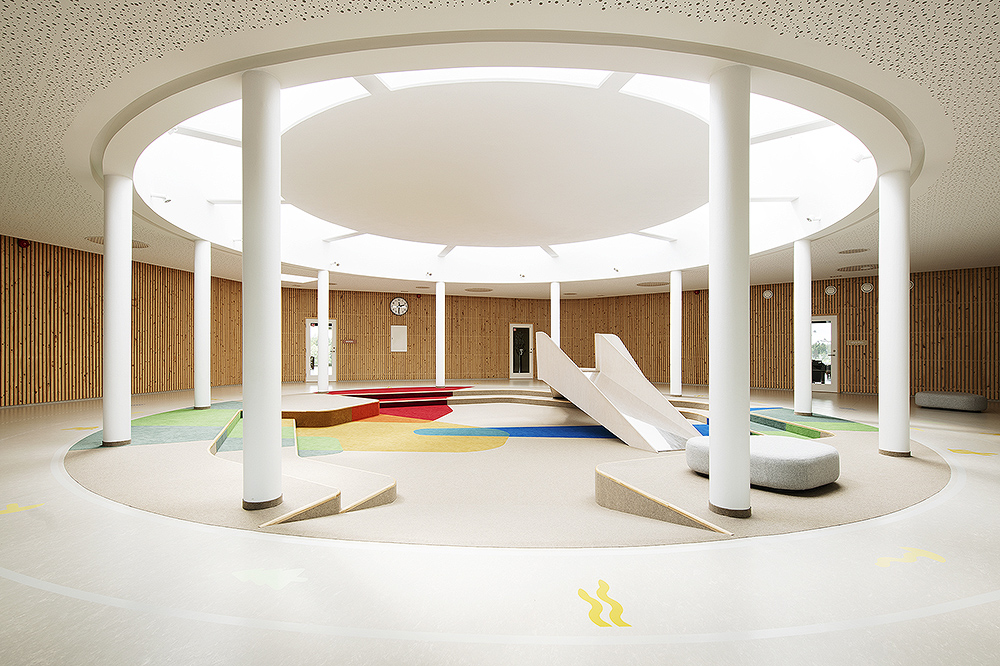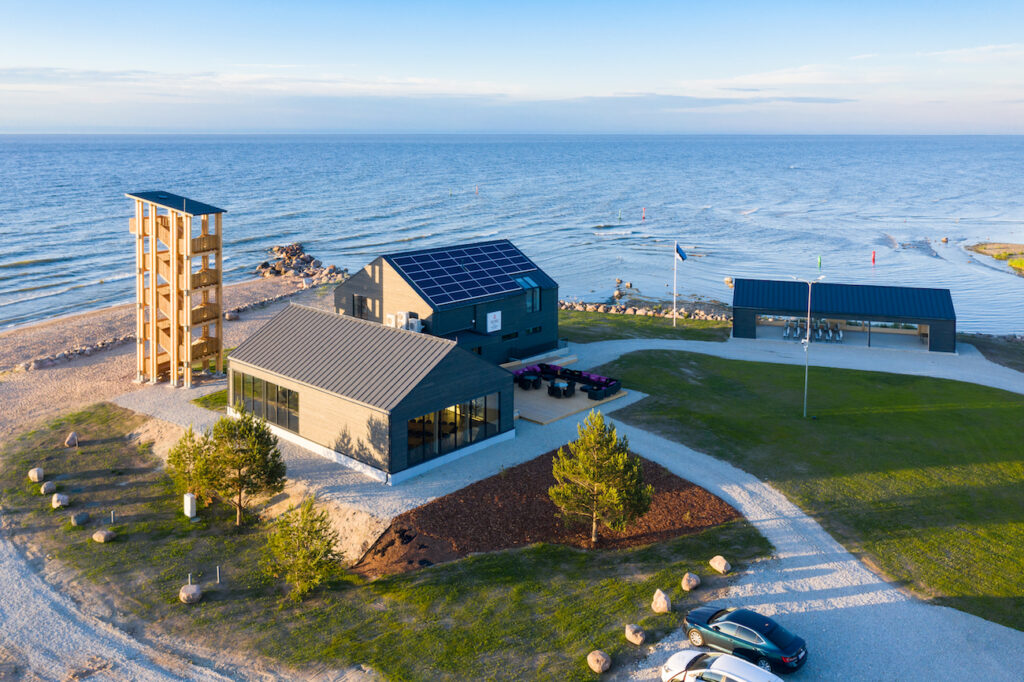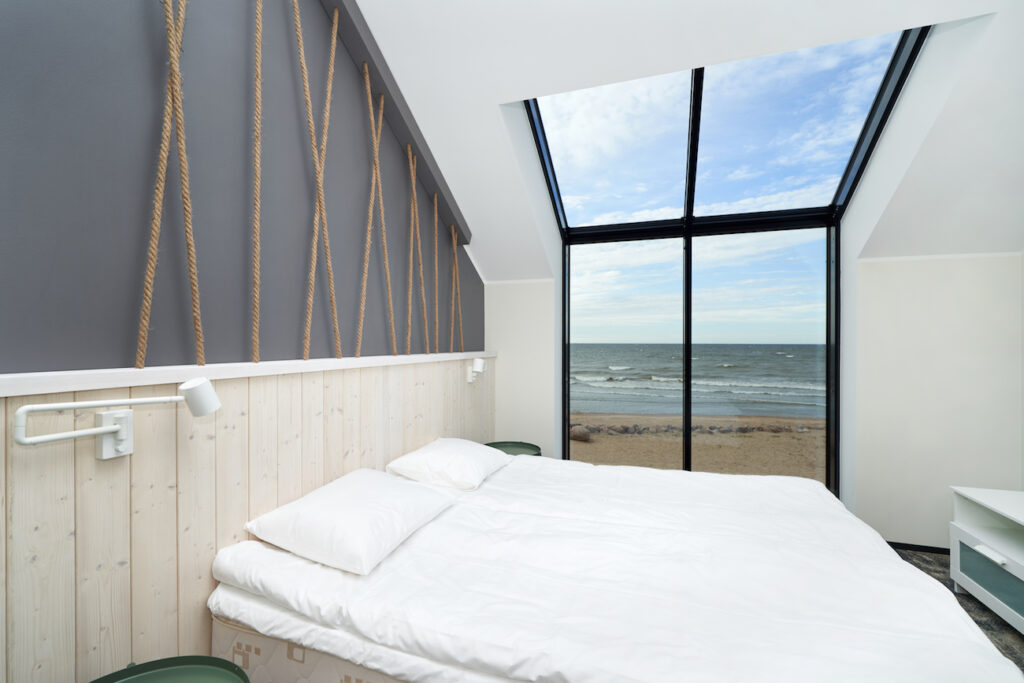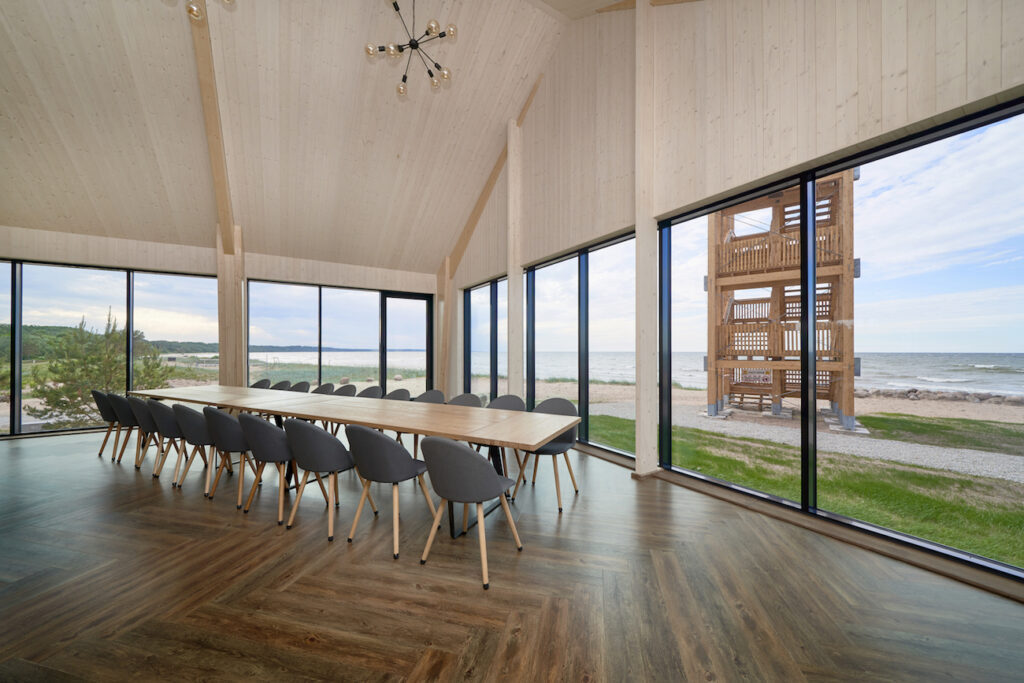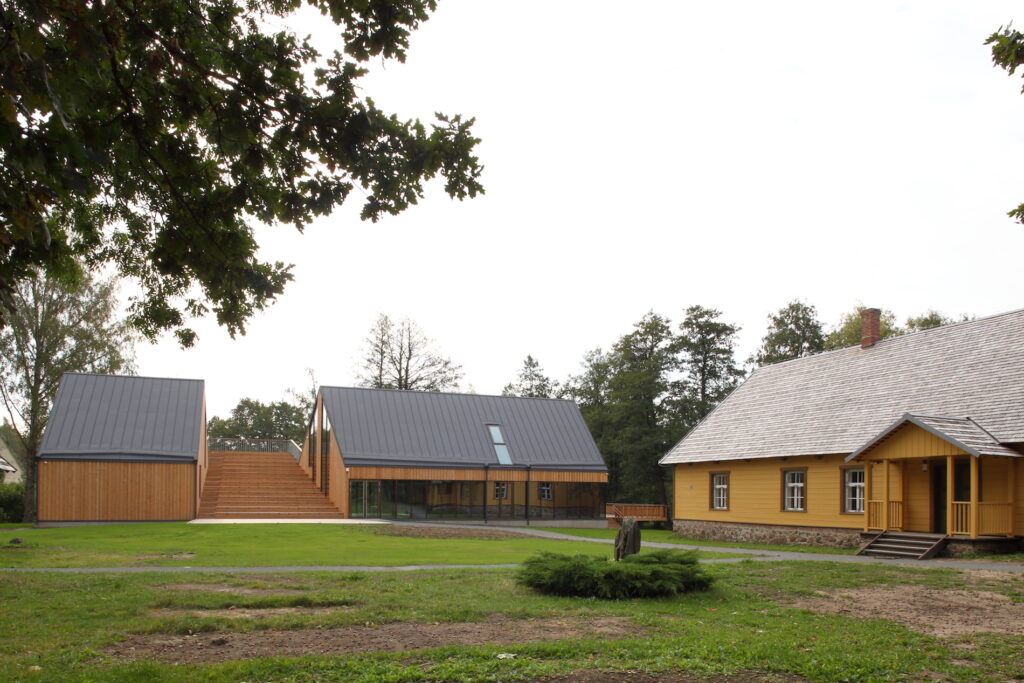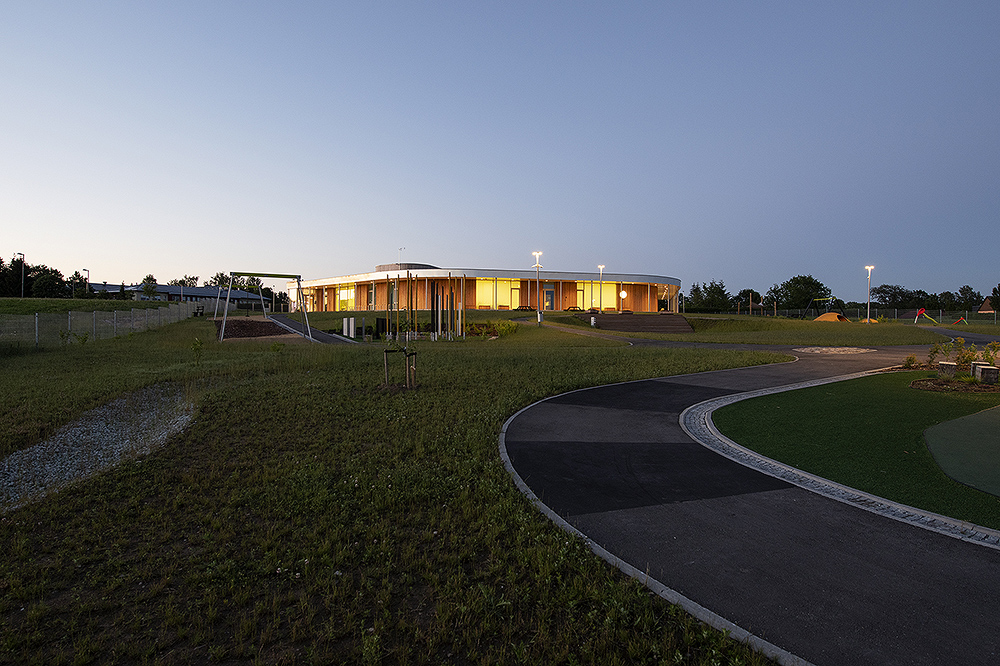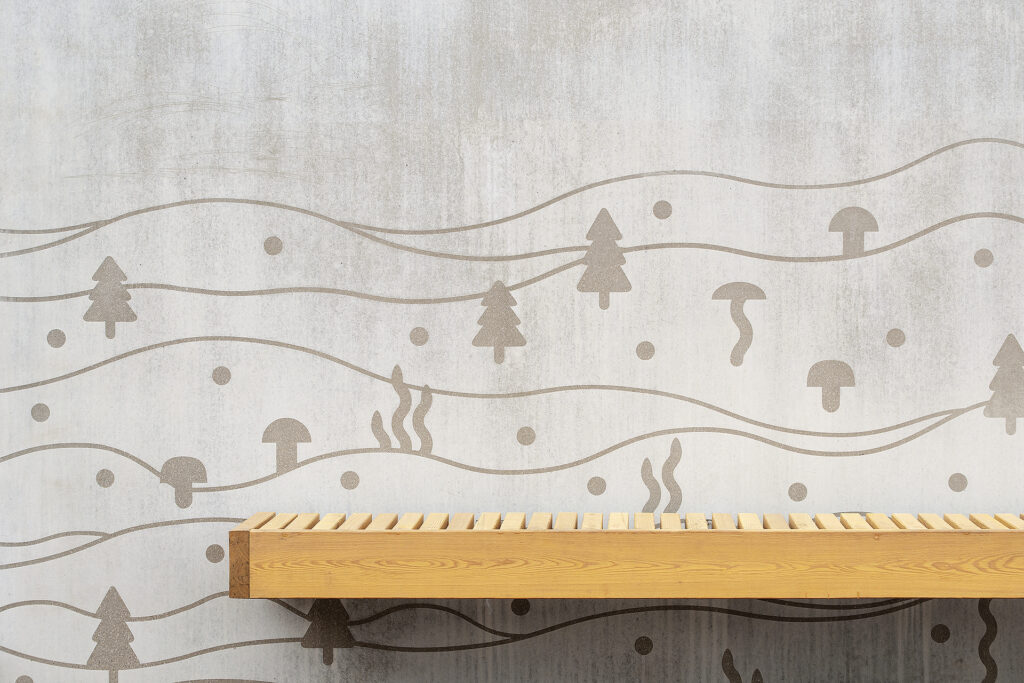Several public buildings that form functional miniature ecologies, impacting our human qualities and sense of proportion through their scale, have been erected in Purtse and Palamuse.
The public perception of Estonian rural life is something reminiscent of a horror story, a heroic epos or romanticised arcadia. True, emergency response is not overly quick to reach a village enclosed in forests, an abundant storm may cause a fight for existence, and esoteric neo-communities are actively inventing a new social order. Yet, there are a number of places where life runs smoothly, rather modestly and without existential chaos. It would be a fair, unexaggerated statement that purposefully informed architecture plays a significant role here. Funding from the EU and regional programmes have enabled the building of many new structures in rural areas. Purtse and Palamuse are great examples of what can be achieved with a well-written project proposal by contributing equal amount of thought to high quality environments and contemplating on what the surroundings might actually need in the long run.
PURTSE
One of the most vivid examples is the Purtse area that has undergone a renaissance of sorts. Culture hobbyists probably know this place in Virumaa by the 16th century fortress residence, representing a 1980s tonality of rather cumbersome restauration style. By now, the harbour at the river mouth has been fixed (2015) and edifices rousing not only the former fishermen’s village Liimala (population 56 in 2018) but the entire region have been built. The traditionalist Tulivee restaurant on the humongous sand beach was completed in 2017 (architect Ralf Tamm, interior architects Angela Orgusaar, Andrea Tamm). The fully wooden modest building seems like an extension to a boathouse – simple, as if attempting to not disturb the eye too much. The main effect comes from the undulating roof, constructed using glued laminated timber frames shifted in various directions. The interior is sure to leave an imprint on those who have come to enjoy the delicious tastes and drinks offered here in a warm, open space radiating with romantic beach-inspired details such as glass buoys in nets hanging from the ceiling.
A good idea accompanied by the seminal influence of Enterprise Estonia (EAS), the European Regional Development Fund and other major benefactors has led to subsequent steps and created a unique „whole package“. A guest house with a mini-exposition on the subject of bootleg trafficking, that is (often heroised) criminal activity, has emerged in the neighbourhood of the restaurant.The design is surprisingly pleasant, featuring a nordic sense of lightness in the rooms surrounded by a dark outer body. The set is complemented by a pavilion with a gable roof, meant for dining but also suitable as a stage area, and a perky observation tower. The interior design and sketches were made by Kerttu Mäesalu whose work was continued by Kalju Kisand. The stylistic wholeness, the use of timber throughout the design and a communal dimension are what earned the Tulivee museum of spirit smuggling and concert centre the Wooden Building of the Year 2019 award.
TULIVEE MUSEUM OF BOOTLEG AND CONCERT PLACE
Location: Liimala küla, Lüganuse vald, Ida-Viru maakond
Architecture: Kerttu Mäesalu / Zeta, Kalju Kisand / Resand
Engineering: Ragnar Pabort / Resand
Commissioned by: Trogar
Constructed by: Mapri Ehitus
Plot surface area: 3095m2
Building net surface area: 605m2
Project: 2014
Construction: 2018-2019
PALAMUSE
A fair share of new houses have appeared in Palamuse lately, inspiring the continuity of the beloved film and literature tourist destination in cultural memory. The Palamuse Parish Schoolhouse and village were celebritised by the juicy stories of Oskar Luts, later perpetuated by theatre productions and even more so by the films of Arvo Kruusement. The physical dimensions of the former schoolhouse became too small as the village grew and education progressed, and learning was distributed between many buildings, which led to the establishment of a completely new, fully modernist school building in 1975. Fortunately, the iconic schoolhouse that had been left empty during the nationalist whir got attached to a new purpose of use, and a hundred years after the birth of Luts, in 1987, a museum was opened in the building.
The Palamuse O. Luts’ Parish School Museum Visitor Centre, a building situated next to the museum, carrying a somewhat euphemistic name characteristic to Enterprise Estonia projects, was completed last year. The head designer of the complex were the architecturally and adminstratively capable KOKO Architects, the design is by ÖÖ-ÖÖ Architects Lembit-Kaur Stöör and Ülo-Tarmo Stöör, interior design by Mari-Liis Süld and Riin Luuk, and the permanent exhibition was tackled by Andrus Kõresaar’s right hand Production Group under the brand name Motor Agency.
It may have been a question of considerable concern how this new large-scale edifice would fit into the local idyllic scenery. Despite the challenge, the Stöör brothers were able to find a composition inherent to an Estonian farm-yard (“talu-yard“). The building stands perpendicular to the schoolhouse and is nicely placed in dialogue with the winding Amme River, appearing surprisingly vigorous with its central stairway simultaneously fulfilling the role of a stage, an observation platform, a staircase and a seating area, seemingly consisting of two gable-roofed pavilions. The architecture fits well into the heart of Palamuse where in addition to the school, there is also a church, a parsonage, a dining room in the granary of the church manor, a pharmacy, a watermill, some posher buildings (such as the Goldberg Villa in half-timbered style), and a song stage.
PALAMUSE O. LUTS’ PARISH SCHOOL MUSEUM VISITOR CENTRE
Construction design: KOKO Arhitektid
Architecture and landscape architecture: Lembit-Kaur Stöör, Ülo-Tarmo Stöör / ÖÖ-ÖÖ Arhitektid
Interior architecture: Mari-Liis Süld, Riin Luuk / ÖÖ-ÖÖ Arhitektid
Exposition: Motor Agency
Engineering: Toomas Tammerik
Commissioned by: Palamuse O. Lutsu Kihelkonnakoolimuuseum, Arne Tegelmann
Constructed by: KRC Ehitus
Plot surface area: 1,3ha
Building net surface area: 566m2 (visitor centre), 487m2 (school)
Project: 2009-2018
Construction: 2017-2018
We might say that ever since Jüri Okas’ eaveless Mardi farmhouse in Saaremaa we have seen all there is to see about buildings that tend toward a rural archetype, but in this scenario the delicately interwoven stylistic choice is well-grounded. Due to the completion of the new building, the museum has become increasingly clever in offering its bespoke theme packs. And rightly so – a small settlement demands greater flexibility from its architecture and it is good when a building can accommodate an exploration day for a kindergarten, sessions for refresher training, weddings as well as wakes. Offered tours include sites connected to Oskar Luts such as the writer’s birth place – Posti farm. Literary and nature-themed tours into the surrounding areas seem exciting, as does the presentation of the legacy of filmmaker Theodor Luts. At the moment, the topic of Lutheran parish schools is being covered in theme blocks in the main building, but there is also a separate film theatre. The solution provided is compact, witty, and of course, interactive. In addition to a new yellow coat, old school has received even more refined century-old interior furnishing, and it is possible to organise different exhibitions under the roof.
The long-awaited kindergarten was completed in Palamuse this year. Although the construction project was costly and there is a plenitude of square metres to use, ensuing management should be a rather moderate task since the building is a nearly zero-energy building (nZEB). The so-called “Bumpy” form, named after the well-known fairytale by Oskar Luts, is lumpy and undoubtedly related to the grass-roofed community centre completed in 2009, which now serves as the service centre for the large Jõgeva municipality established in 2017. One of the first totally new community centres since the country regained its independence was designed by Urmas Luure, Tõnu Rebane, Marit Vendel. The building whose exterior is reminiscent of a cake with a few missing slices was introduced as the first passive house (a low energy building, in fact) meant for public use, and was inhabited by the former boarding school in 2009, while managing to accommodate not only the parish clerk but also the constable. However, many locals at the time discerned that there ought to have been more flexibility integrated into the use of the building, and a broader scope for different types of meeting. Indeed, even today after a painful administrative reform that deprived many parish and village community centres of their original function, we would only gain from contributing to a more dynamic use of space, since clinging to office rooms and festivities is not enough to sustain a community.
PALAMUSE KINDERGARTEN
Construction design: Kauss Arhitektuur
Architecture: Urmo Mets, Allan Pilter / Kauss Arhitektuur
Interior architecture: Lauri Eltermaa, Grete Veskiväli / Kauss Arhitektuur
Landscape architecture: Anna-Liisa Unt, Robert Kähr / Lahe Atmosfäär
Engineering: Inseneriprojekt
Graphic design: Martin Rästa
Construction and owner: KRC
Client and tenant: Jõgeva linnavalitsus, kindergarten ‘Nukitsamees’
Plot surface area: 9348m2
Building net surface area: 2000m2
Project: 2015-2018
Construction: 2018-2019
Urmo Mets and Allan Pilter, the architects behind the kindergarten, find that that design resonates with the round and expansive nature of the Vooremaa (“Drumlin Land“) hillscape, and of course the neighbouring parish house. Regarding stereotypes, many are inclined to believe that roundness is somehow more child-like. Whether spheres convey a more endearing and gentle atmosphere than cuboids is unknown, yet the last decades have seen a growing trend in designing curved walls in childcare facilities. One of the better known examples is undoubtedly the primary school building of the Rakvere Private High School with a slightly esoteric beat (2006, by Laur Pihel, Tauno Aadma). Of the more recent ones, the slightly monstrous Hanssoo Middle School surrounded by a spiral inclination (2019, by Sirkel & Mall) comes to mind.
Similar horizontally grounded sod houses have appeared in our architecture before. The most prominent one is perhaps the Otepää snowsports centre (1978, by Peep Jänes, Tõnu Mellik), also known as the Pentagon, reminiscent of a bomb shelter and phantasmagorically extreme: an unprecedented open donut-shaped structure, whose slanted external walls were originally covered by grass in the warm season, turning into a snow roof in the winter, as if blending in with the environment of those wearing military camouflage.
Situated on a slope more than a metre below street level, Palamuse kindergarten is also mildly hidden from plain sight. The architecture of the building radiates somewhat green values: a solution with no acute angles bears the name “organic“, the interconnectedness between the exterior and the interior has clearly been a conscious concern, landscape architects were involved from the very beginning phases of the project.
In addition, amicably, the house is one-storeyed, thus welcoming of children with special needs and considerate of the toddler group. The complex has been designed to accommodate five groups, that is about 116 children. An innovative creative space, motion room and music room have been added that can also be joined into one hall by opening the dividing walls between them. The winter garden has been a quickly adopted delightful element, allowing the children to sow their own seeds in a group, follow the growth and take care of the developing plants until they bear fruit. A considerable luxury has been added in the form of a swimming pool with adjustable depth, whereas the movable bottom also functions as a 60-metre surface cover to keep anyone from sploshing into the water.
The rooms of the building are circled around a common play area, whose partially glazed ceiling resembles a stylised sun. It is rather impressive, in fact, how viable the old Roman domus -based, atrium-centered layout has proven to be, especially in public buildings! Views of the forest open from the rooms of the kindergarten, and children have already reported seeing deer and even a fox. The interior is somewhat low-key – dim shades prevail in activity sites moulded into the plywood, meant to inspire peeping and climbing games. On that note, the graphics design by Martin Rästa fits in well with the mild theme of organic forests and rhythms.
Unadulterated fun should be available despite the weather, and thus the space in front of the nursery rooms is defined by a roofed terrace. One can’t help but poke that unlike the sheltered area at the awarded Arvo Pärt Centre, this one can actually be used. Landscape architecture was designed by Anna-Liisa Unt and Robert Kähr, who have admitted that budget reasons kept their ideas from being fully realised in this case. Despite that, the completed ensemble feels multi-faceted and proportional compared to the many childcare facilities in the capital that seem to be tending towards industrial dimensions, one might say. The designers have evaded fantasy-depriving suggestivity, and focused on creating an environment supportive of personal mental alertness and different bodily experiences.
Palamuse and Purtse both exemplify well how success is achieved by contributing to keeping pace with time through architecture, not just by relying on seasonal trends to guide the development. Free bus service no doubt pleases a rural citizen, but local agenda should be stimulated as well. Entrepreneurs at Liimala beach are prompting more expensive services instead of eco-tourism, but locals are also encouraged to gather at the inn or attend concert activity. Palamuse is an interesting place to be not only when visiting the Paunvere field exhibition, but also on every other day of the week. The museum is not intended as a single-use consumption object, it is more like a living organism. Together with the parish house and the kindergarten – also sites worth visiting as carriers of Estonian life-style, neo-spirituality and eco-values – it helps one to manage, and remain socially active. These necessary establishments with a pleasant appearance encourage people to respect their home and settle down in the midst of reasonable amenities and entertainment.
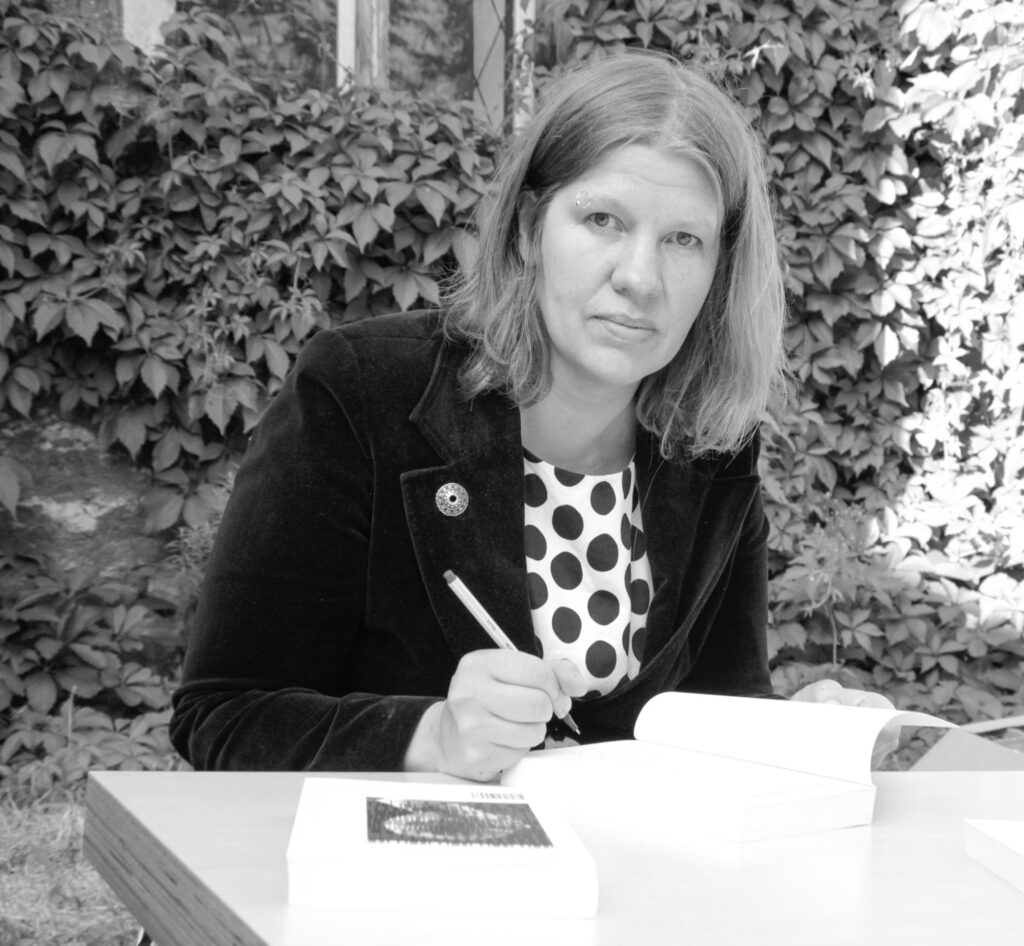
KARIN PAULUS is devoted to writing about architecture and design, curating exhibitions, and teaching at the Estonian Academy of Arts, Pallas University of Applied Sciences and Tallinn University of Technology.
HEADER: Palamuse kindergarten. Photo by Terje Ugandi
PUBLISHED: Maja 99 (winter 2020) with main topic Rural Insights

